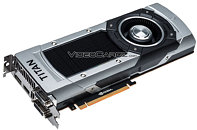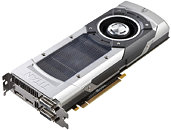Tuesday, February 11th 2014

GeForce GTX TITAN Black Pictured, Isn't Strictly Black
Here's the first alleged picture of NVIDIA's GeForce GTX TITAN Black, a high-end SKU NVIDIA is working on, to restore the competitiveness of the $999 price-point it commands. Although referred to as "TITAN Black," the card is nowhere close to looking like the CGI renders that surfaced last November. The board looks identical to the original GTX TITAN, except its "TITAN" etching on the cooler shroud is painted in black. The GTX TITAN Black maxes out the 28 nm GK110 silicon, featuring 2,880 CUDA cores, 240 TMUs, 48 ROPs, and a 384-bit wide GDDR5 memory interface, holding 6 GB of memory. It also features full DPFP for the GK110 silicon, which is exclusive to the GTX TITAN, within the GeForce range. NVIDIA is expected to give the GTX TITAN Black a low-key launch some time next week.
Source:
VideoCardz


32 Comments on GeForce GTX TITAN Black Pictured, Isn't Strictly Black
I doubt we will see a performance delta like when we moved from the 7xxx series GeForce cards to G80 based GTX 8xxx series cards. The times when we've seen huge gaps in processing power on new chips vs. old have usually been when a manufacturer made a misstep with the previous design; like the P4 to Core 2 you note above. P4 was a brand new architecture which just simply was not as efficient as the P3 architecture was (and coincidentally what the Core 2 was based on).
Now, the 7xxx series wasn't that much of a misstep especially compared to the 5xxx series, but it still was a small plateau before the big drop of G80.
Once we start seeing Maxwell on 20nm I think we'll see a good improvement in performance.
Al Sharpton is going to be upset at Nvidia
Low Key release during Black History Month
The look on Jules face when he noticed the card wasn't black
:D
And that pretty much had to stop when things started running into heat and power limits.
The 8800GTX was only 175W, GTX285 200W, and we finally hit the 250W ceiling with GTX480. After that all gains had to be made from design and process because TDP was pretty much maxed out.
Same thing for ATI/AMD. 3870 105W, 4870 150W, 5870 228W, and with the 6970 250W where it's stayed since.
Efficiency is the new speed. If Maxwell can perform same as Kepler at 1/2 the power, then we might just see a doubling of performance at the high end.